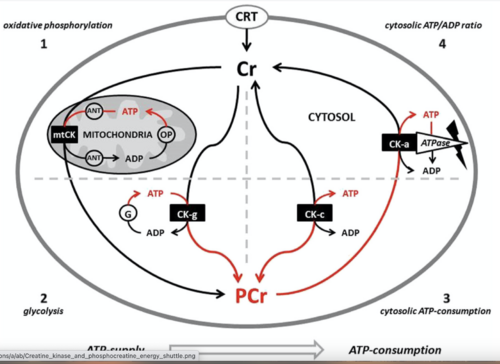Creatine Phosphokinase (CK or CPK)
Original Editor - Lucinda hampton
Top Contributors - Lucinda hampton, Kirenga Bamurange Liliane and Vidya Acharya
Introduction[edit | edit source]
Creatine phosphokinase (CPK) AKA creatine kinase (CK) is found in the tissues of the body where energy demands are typically high. This includes skeletal muscle, the heart and brain, though this enzyme is found in a number of other tissues as well. Within these tissues, CK is found in the mitochondria, the cells powerhouse.
CK is the enzyme that catalyzes the reaction of creatine and adenosine triphosphate (ATP) to phosphocreatine (PCr) and adenosine diphosphate (ADP). It is a reversible enzyme reaction that subsequently produces ATP from PCr and ADP. The PCr made is then used to supply tissues and cells that need substantial amounts of ATP, for instance the brain, skeletal muscles, and the heart, with this much needed ATP. Creatine phosphokinase (CK) is a major controller of homeostasis in cells.
Numerous conditions cause disruption of CPK levels, including rhabdomyolysis, heart disease, kidney disease, and certain medications.[1]
CK in Blood Tests[edit | edit source]
The appearance of CK in blood tests is usually considered an indirect marker of muscle damage, especially for diagnosis of medical conditions such as myocardial infarction, muscular dystrophy, and cerebral diseases (eg injuries and infections to the brain, brain tumors and dementia).
- Naturally muscle cells will release CK as a part of day to day life. Certain people eg certain ethnic groups, fit men with larger muscles have naturally a higher normal CK level than other people (for example older women).
- Heavy exercise can cause higher CK levels, as well as muscle damage caused by eg a fall, an injection into a muscle, road trauma, surgery. Not all exercise creates the same CK response. A large increase in plasma creatine kinase occurs after eccentric loading, however only a small increase in CK levels in the blood after concentric loading occurs. In some medical conditions (eg myositis, muscular dystrophy) were elevated CK levels is a feature concentric exercise should be considered over eccentric exercise. A concern with elevated CPK levels is the potential risk of kidney dysfunction - strenuous exercise increases the risk in susceptible individuals.[2] [3]
- The molecular mechanisms causing CK release from muscle after mild exercise remains unclear. Clarification would help give important information for those concerned about muscle hypertrophy, performance, and the significance of rest periods between periods of exercise.[4]
Specific Examples[edit | edit source]
- CK activity is one markers of acute myocardial infarction. [1] CK activity starts to increase within 12 hours of MI symptoms, peaking at 24 to 36 hours, and returns to normal after 48 to 72 hours.
- Serum CK activity is greatly elevated in all types of muscular dystrophy, falling in these patients as they age and as the total amount of functioning muscles declines (sarcopenia) with disease progression
- CPK levels elevate in patients with rhabdomyolysis [1]which may occur post crush injury, drug use, viral infections, and strenuous exercise. It usually presents with muscle pain and weakness and dark-colored urine.
- Certain drugs, eg cholesterol-lowering drugs (statins), can damage muscle and increase CK. Patients on statins such as simvastatin may have an adverse effect of significantly elevated CPK levels, potentially leading to rhabdomyolysis.
- Serum CK activity has an inverse relationship with activity of the thyroid, with 3/5 hypothyroid persons showing an average elevation of CK activity 500% greater than the upper reference limit.[1]
References[edit | edit source]
- ↑ 1.0 1.1 1.2 1.3 Aujla RS, Patel R. Creatine Phosphokinase. StatPearls. Treasure Island (FL).
- ↑ Koller A, Müller E, Artner-Dworzak E, Haid C, Schobersberger W, Puschendorf B, Raas E. Metabolic Changes Following Concentric and Eccentric Exercise in Trained and Untrained Subjects. InAdvances in Ergometry 1991 (pp. 406-409). Springer Berlin Heidelberg. Available:.https://link.springer.com/chapter/10.1007/978-3-642-76442-4_57 (accessed 5.2.2024)
- ↑ Pathology tests explained. CK Available at:https://www.pathologytestsexplained.org.au/ptests-pro.php?q=Creatine%20kinase%20(CK) (accessed 5.2.2024)
- ↑ Baird MF, Graham SM, Baker JS, Bickerstaff GF. Creatine-kinase-and exercise-related muscle damage implications for muscle performance and recovery. Journal of nutrition and metabolism. 2012 Oct;2012.







